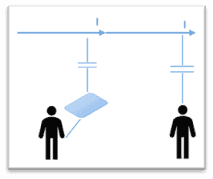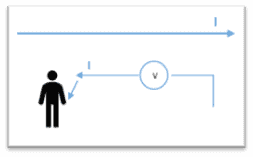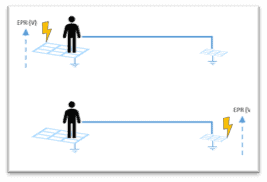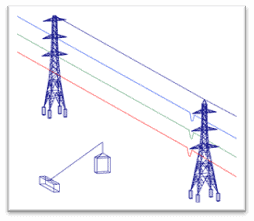

Robert Knott & Stephen Lilley
To meet global net zero targets, the construction of renewable energy installations is increasing. These generation sites are often installed adjacent to existing High Voltage (HV) infrastructure to enable connection to the electricity network, and this presents risks to persons from electric shock, burns and fire during the construction phases of the new development. These impressed voltages (IVs) that may be present during construction must be understood, identified, assessed, and managed to ensure compliance with industry standards and safety for all persons on the construction site.
What are impressed voltages?
Impressed voltages (IVs) are voltages that appear on metalwork when in the close vicinity of live equipment, such as overhead lines or buried cables, due to the strong electromagnetic fields that are present around these energized systems.
IVs may be categorized into three main types of coupling: Electrostatic, Electromagnetic and Conductive.
Electrostatic coupling occurs when a conductive object or person is near a conductor with a raised potential and the object is in contact with the earth.
|  |
 | Electromagnetic coupling happens when a conductive object such as a cable, is in close proximity to a conductor carrying a current. The voltage and current observed within the object will be higher the closer the object is to (or parallel to) an HV conductor.
|
Conductive coupling happens when there is a fault in a system that is connected to earth. Current will flow through the conductor and the earthing system during fault conditions, creating an Earth Potential Rise, or EPR.
|  |
Why do they matter?
Several incidents have occurred within the UK over recent years, which have been acknowledged as a direct result of failure to adequately manage impressed voltages. A safety bulletin produced by National Grid in 2015 [1], raises the need for awareness and understanding of IVs during construction activities and the ability to manage IVs.
Furthermore, in accordance with Construction (Design and Management) (CDM) regulations 2015, developers and contractors must provide a safe place of work for personnel during the construction phase of an HV installation. The potential hazards of IVs can disrupt normal construction activities and must be evaluated and mitigated to ensure safe working areas for site personnel.
How PSC can help
 PSC offers a comprehensive IV study to help our clients identify potential impressed voltage hazards and methods of mitigating their impact on site personnel during construction, maintenance, and installation activities.
PSC offers a comprehensive IV study to help our clients identify potential impressed voltage hazards and methods of mitigating their impact on site personnel during construction, maintenance, and installation activities.
The studies we perform use industry-leading software [2] to model HV systems and infrastructure and to perform detailed calculations to assess induced voltages and currents seen on temporary buildings, fencing, plant and machinery used during the construction process.
Learn more about our capability in this area or contact us to find out how we can help you.
References
| [1] | Safety Bulletin SB/409, Impressed Voltage Update, Issued by National Grid, 11/08/2015 |
| [2] | CDEGS (Current Distribution, Electromagnetic Fields, Grounding and Soil Structure Analysis). SES & technologies Ltd, 3055 Boulevard des Oiseaux, Laval, QC H7L 6E8, Canada. |
